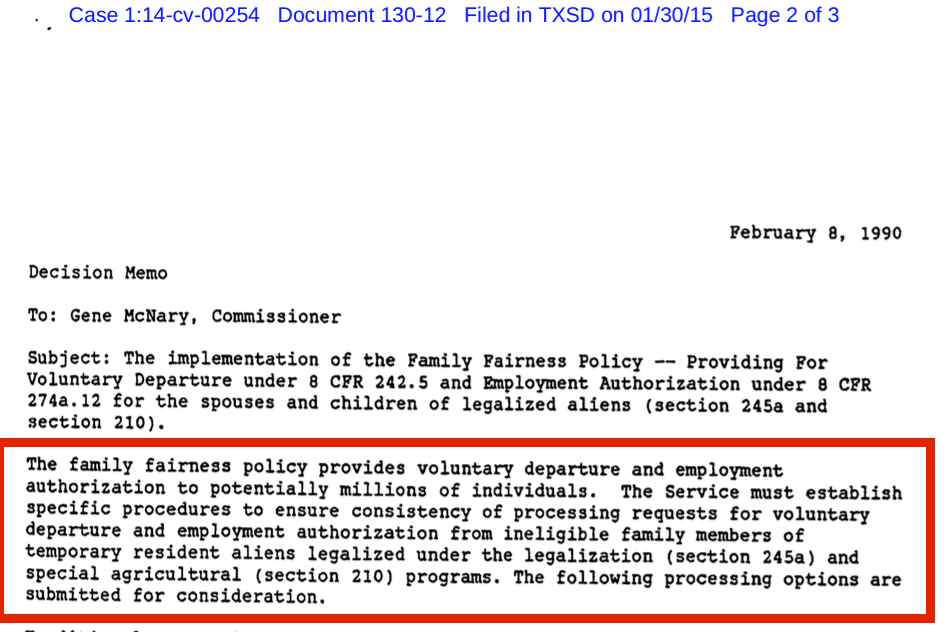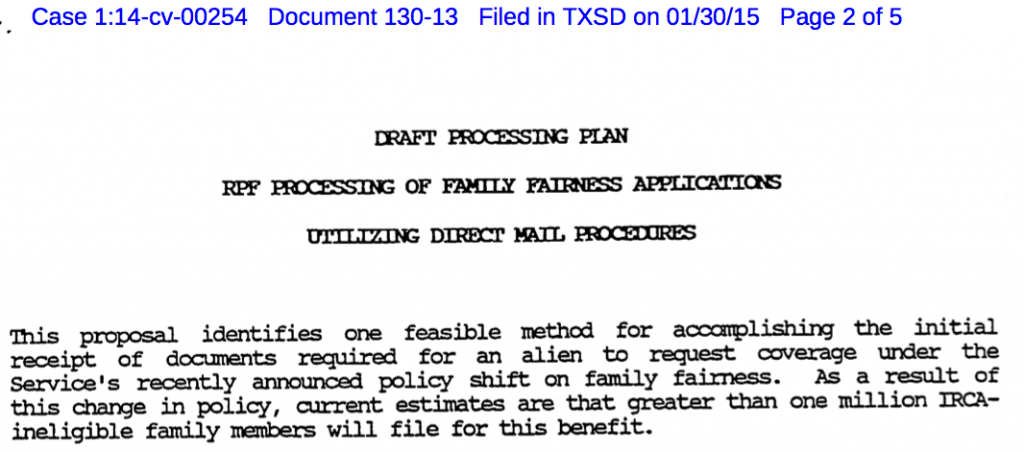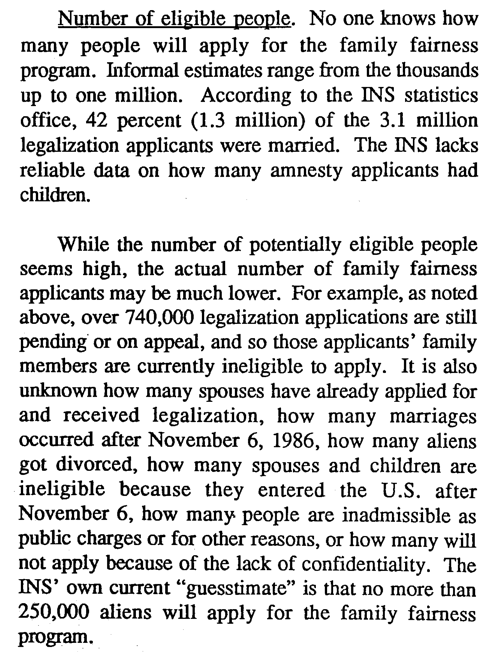In order to promote DAPA, the Administration repeated over and over again that President Bush deferred the deportation of 1.5 million aliens in 1990, a number that was then nearly half the size of the undocumented population. While the DAPA and the Family Fairness Program of 1990 are quite dissimilar with respect to how they operate, it turned out that the number of aliens who received deferrals wasn’t even close to 1.5 million–it was closer to 50,000. As I note in Part II of my series on DAPA:
The OLC Opinion repeated an oft-cited, but incorrect statistic that President George H.W. Bush’s “Family Fairness” deferred the deportation of 1.5 million. See OLC Opinion at 14. This statistic has been repeated by the President. This Week (Nov. 23, 2014) http://abcnews.go.com/ThisWeek/week-transcript-president-obama/story?id=27080731 (“If you look, every president—Democrat and Republican—over decades has done the same thing. George H W Bush—about 40 percent of the undocumented persons, at the time, were provided a similar kind of relief as a consequence of executive action.”). The actual estimate was roughly 100,000. Glenn Kessler, Fact Checker: Obama’s Claim that George H.W. Bush Gave Relief to ’40 percent’ of Undocumented Immigrants, Wash. Post (Nov. 24, 2014), http://www.washingtonpost.com/blogs/fact-checker/wp/2014/ 11/24/did-george-h-w-bush-really-shield-1-5-million-illegal-immigrants-nope. The origin of this false number is subject to some dispute, and seems to be based on an error in congressional testimony. McNary himself told the Washington Post, “I was surprised it was 1.5 million when I read that. I would take issue with that. I don’t think that’s factual.” Ultimately, by October 1 of 1990, INS had received only 46,821 applications. Id. The next month, President Bush signed the Immigration Act of 1990, which ended the temporary family fairness program.
In its initial filings in Texas v. United States, the government repeated the 1.5 million number without any analysis. But in its sur-reply, the government doubled down on the 1.5 million number (p. 28). They acknowledge that though a “limited number of people” actually applied, what counts is the number of “potential applicants.”
Plaintiffs also argue that prior programs identifying certain groups of aliens who may be eligible for an exercise of discretion were of a different “kind or scale.” See Pls.’ Reply at 18-19. Of course, this alone is not dispositive of the lawfulness of the present initiative. In any event, Plaintiffs fail to distinguish the 2014 Deferred Action Guidance from the Family Fairness Program of 1990, which addressed a similar type of family-based classification23 and reflected a statutory concern for promoting unity among U.S. citizens and their undocumented families. As to the scope, although a limited number of potential recipients ultimately applied for temporary relief under the 1990 Family Fairness Program, see Pls.’ Reply at 19, the relevant data point for comparison purposes is the number of potential applicants estimated at the time of the program’s announcement, which was 1.5 million.24
See Defs.’ Ex. 8 (“At the time, [INS Commissioner] McNary stated that an estimated 1.5 million unauthorized aliens would benefit from the policy.”); see also Decision Mem. to Gene McNary, The Implementation of the Family Fairness Policy at 1 (Feb. 8, 1990) (Ex. 45) (stating that the program would provide voluntary departure and employment authorization “to potentially millions of individuals”); Draft Processing Plan, Processing of Family Fairness Applications, Utilizing Direct Mail Procedures at 1 (Feb. 8, 1990) (estimating that “greater than one million IRCA-ineligible family members” would file for relief under the announced policy) (Ex. 46).
But the number of “potential applicants” is also in dispute. Beyond the testimony of McNary–which he admits was mistaken–the government cites two documents. First a “Decision Memo” to Gene McNary, dated February 8,1990, that was previously unearthed by Rep. Zoe Lofgren. Here is the relevant portion:

The second document in the Government’s sur-reply is new (to me at least). It is an undated Draft Processing Plan of how to use direct mail to handle the Family Fairness Plans. It states that “current estimates are that greater than one million IRCA-ineligible family members will file for this benefit.”
The Washington Post Fact Checker tracked down Thomas Andreotta, the author of the Draft Processing Plan. He said the estimate was way off target:
The Fact Checker contacted Thomas Andreotta, a retired career official listed as the author of the implementation plan. He did not have a specific recollection of the memo but he dismissed the numbers in it.
“A million sounds like the kind of hyperbole I might have written,” he said, but “100,000 is more likely to be closer to the real number.” He explained that for internal purposes, estimates were routinely inflated into order to get the resources necessary, as at the time the agency was part of Justice Department and (he said) frequently got short-changed. “As the quartermaster said, if you want five, ask for ten and then they will give you four,” he quipped.
Another Senior INS Official echoed these comments:
Louis D. Crocetti Jr., another career senior INS official at the time, echoed Andreotta’s recollection about inflated internal estimates being necessary to obtain funding. “You wanted to be sure you estimated high,” he said. Crocetti said the fact that fewer than 50,000 people applied for the benefit in 1990 indicated that “the 100,000 was even a high estimate.”
Beyond McNary’s testimony, published media accounts were as low as hundreds of thousands and as high as 1.5 million:
With the exception of The New York Times a few weeks later, no other news organization appears to have reported on the exchange.
Administration officials also pointed to a 1989 Los Angeles Times article about a Senate vote predating Bush’s action, which quoted an unnamed aide to a senator as saying that such a move would affect 1.5 million immigrants; other news articles on the vote said “hundreds of thousands.” None of the estimates appeared especially well-grounded.
Meanwhile, despite these high numbers, the potential applicant pool appeared much smaller. FactCheck.Org, which exhaustively reviewed previous presidential actions, found an article that appeared on Feb. 26, 1990, in the Interpreter Releases, a weekly newsletter on immigration news, that explained how fuzzy the data was on the number of people who might take advantage of the new policy. (Note that the article appeared after McNary’s congressional appearance.)
Here is the key excerpt from the 1990 article, explaining that it is impossible to know how many will actually apply.
At bottom, the evidence is in conflict. McNary’s testimony may have been referring to some other number. The numbers from the INS documents cited “millions” or “greater than one million.” These numbers are worlds apart, and do not seem like precise estimates. Some media before the policy was announced repeated the 1.5 million number. Other media afterwards put forward numbers in the ballpark of a 200,000 (roughly the number who inquiries).
We may never know what the right answer is here. But, I’m not sure it matters. The sur-reply adds in a footnote that there likewise remains “uncertainty” about the total number who will sign up for DAPA, based on DACA signup rates.
There remains uncertainty regarding how many people will apply for or receive deferred action under the 2014 Guidance. Approximately 1.2 million people, for example, were estimated to be eligible for deferred action under 2012 DACA when the program was announced. But as of December 31, 2014, only 638,897 of DACA eligible individuals had been granted deferred action. See Neufeld Decl. ¶ 23. Moreover, any comparison between the number of aliens who may receive deferred action under the 2014 guidance and those who received temporary relief under the Family Fairness Program would also have to take into account that Congress enacted a statute in 1990 providing certain relief less than a year after the program’s announcement, thereby rendering the program unnecessary. See infra note 25.
With the last sentence, the government unwittingly distinguishes Family Fairness from DAPA. As I noted here, Family Fairness was meant as a temporary, seven-month stop gap measure between the passage of immigration reform in the House, and its eventual passage in the Senate. It was indeed temporary, and never meant to last beyond that period. DAPA, in contrast exists in the absence of any legislative movement. The size and scope, by itself, is not enough to render it unconstitutional. What matters most is whether the President is acting consonantly with Congress.
Update: After re-reading the OLC Opinion, I recognized that OLC treats the Family Fairness program quite differently than deferred action connected wtih VAWA, VTVPA, Katrina, and Widows.
The OLC Opinion does not count among these five exercises of deferred action the 1990 “Family Fairness” program instituted under President George H.W. Bush. It is only briefly mentioned twice in the Opinion.[1] OLC characterizes the “Family Fairness” policy not as a deferred action program, but a “voluntary departure program.”[2] Specifically under the policy, aliens are “potentially eligible for discretionary extended voluntary departure relief,” not deferred action. Further, the OLC opinion acknowledges that DAPA will “likely differ in size from these prior deferred action programs,” making abundantly clear that DOJ did not consider DAPA a deferred action program.[3] Finally, unwittingly, the OLC Opinion makes clear that the Family Fairness program fits within the “bridge” construct: “INS implemented a “Family Fairness” program that authorized granting extended voluntary departure and work authorization to the estimated 1.5 million spouses and children of aliens who had been granted legal status under the Immigration Reform and Control Act of 1986.”[4] Precisely. The temporary relief afforded to the beneficiaries of Family Fairness was ancillary to the 1986 IRCA. The memo even makes clear that “Congress later implicitly approved.”[5] This acquiescence is lacking for DAPA.
[1] OLC Opinion at 14-15, 30-31.
[2] Id. at 30.
[3] Id. at 30.
[4] Id. at 14.
[5] Id. at 31.

